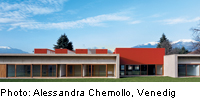Crèche and Nursery School in Covolo

The starting point and source of inspiration for the design of this nursery school with crèche can be found in the broad landscape around Treviso, with its vineyards and wheatfields. Above all, the rough stone walls that dissect the countryside are an important element reflected in the architecture – for example, in the exposed concrete facade with surface chippings on the side facing the town to the west. On the eastern face, in contrast, there are broad areas of glazing, which afford the children a view of and direct access to the garden from all six group rooms. The transitional area between indoors and outdoors is carefully articulated with a projecting roof and with bonded gravel paving.
At the heart of the development is a large assembly hall, which functions like a village square, forming a focus of communication for staff and children alike. In addition, it can also be used for special activities, and the children can eat together here or play in bad weather. The hall also serves as a circulation space, providing access to the group rooms, dining room, playground and garden. Six rooflight lantern strips ensure that the deep layout receives adequate daylight. They also articulate the access areas and the two internal recreation spaces into individual zones. The group rooms are divided into two sections. Those for the smaller children are situated close to the entrance and the sleeping areas. They can be joined by sliding doors aside, thereby allowing a flexible use. The rooms for the children of preschool age are located on the other side of the hall and form a self-contained unit in conjunction with the adjoining sanitary facilities. All spaces have a straightforward structure and are sparsely furnished.
Thanks to the underflooring heating, the entire building is a potential play area. By accentuating the threshold zones in terms of their colour and construction, a means of orientation was created for the children. The design of the various zones is in accordance with the pedagogic concepts of Reggio Emilia, which seek a balance between spatial latitude and stimulating impulses
